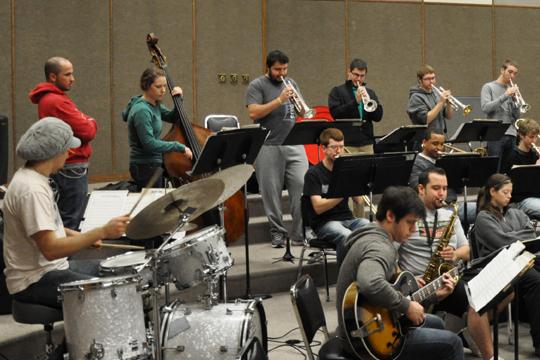Class takes students on a jazz odyssey
January 27, 2012
Craig Treinen, Washburn University director of jazz studies and applied saxophone has taught at the university for seven years.
“We had one jazz ensemble here when I started, and that was it,” said Treinen. “You didn’t have applied jazz lessons or small group opportunities.”
Treinen, a 1990 Washburn graduate, currently instructs jazz ensemble one, jazz combos one and two along with other music courses. Jazz ensembles are typically about 20 students, while combos are usually six to eight performers or less. Treinen gives private lessons in applied jazz and classical saxophone, as well as instructing an education course, Elementary and Secondary methods.
“There’ve been several directors before me, but the jazz department has been around for at least 30 years. It’s kind of grown to where you have more courses available for you,” said Treinen. “We have a jazz history course available as well.”
A jazz history class is offered as a general education course at the 103 level from the music department, friendly to non music majors. “You don’t have to have any musical background or knowledge of jazz, you just have to be willing to get into to it and listen to it,” said Tom Morgan, associate professor of music. Morgan is the director of percussion studies, although he has a background in jazz.
The class was first introduced more than 10 years ago, but it didn’t start out as Jazz History. It was first a class covering jazz, pop and rock genres. “Trying to cover only jazz in one semester is insane, all together is too much,” said Morgan.
Starting with the basics of music, instrument functions and general jazz terms, the course progresses its focus on the actual survey of jazz history. It starts with influences of jazz, such as 20th century African American folk music, ragtime and European styles among others . Then the origins of jazz are discussed, from New Orleans, Chicago, New York and even Kansas City. The class then progresses to jazz presently and the many different branches. From the influences and origins of jazz music to the early innovators, several topics are discussed.
The next jazz concert is scheduled for March 8, which will feature all jazz ensembles and small groups.
The Coleman Hawkins Jazz Festival is scheduled for April 13. The festival includes a day full of jazz, starting around 8 a.m. and lasting until about 10 p.m. Coleman Hawkins was a major and influential tenor saxophone player, who has been rumored to have attended Topeka West High School and Washburn University.
“That’s our big event of the year that usually features a lot of high school and college bands, as well as guest artists,” said Treinen. New Vintage Big Band, a group from Kansas City will perform a concert in the evening.
The last scheduled jazz concert will take place May 3. All concerts take place at White Concert Hall and begin at 7:30 p.m.
“If you’re curious and you’ve never been to a live jazz performance, attend one of the concerts,” said Treinen. “The evening concert of the jazz festival is free, so students should come and enjoy.”



